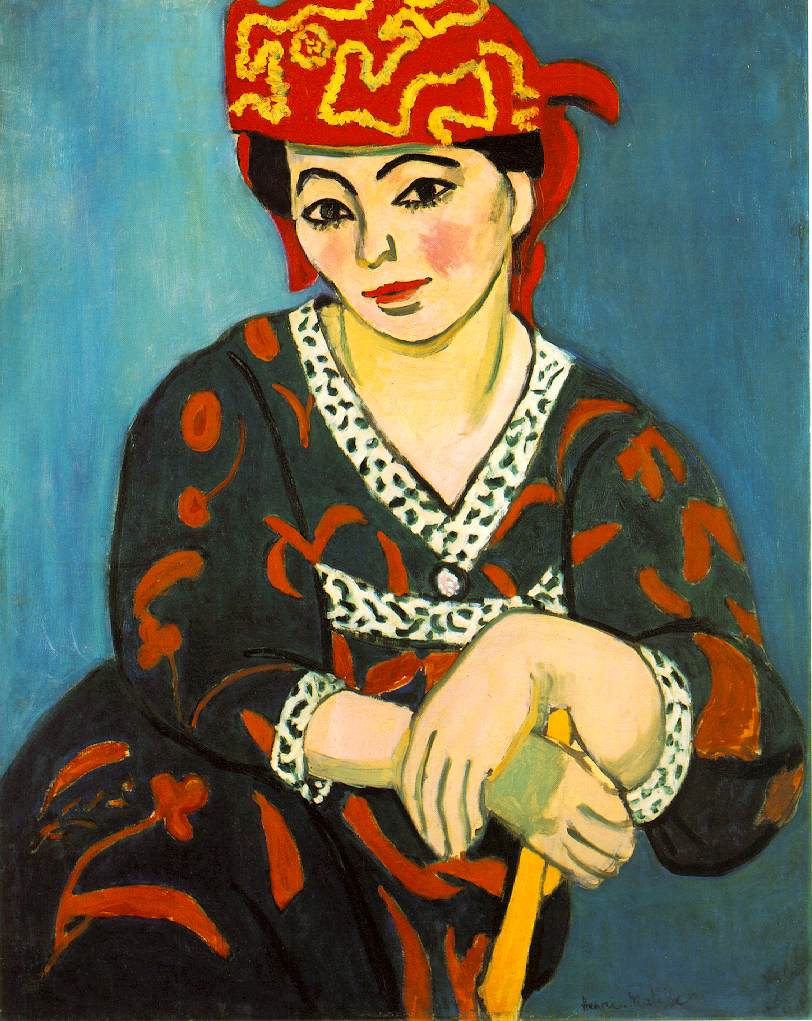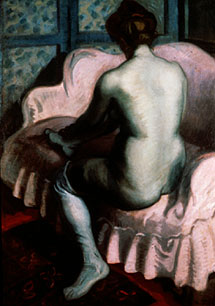Post by sacrilegend on Apr 30, 2007 4:04:46 GMT -5
Fauvism
From Wikipedia, the free encyclopedia
Les Fauves (French for The Wild Beasts) were a short-lived and loose grouping of early Modern artists whose works emphasized painterly qualities, and the use of deep color over the representational values retained by Impressionism. Fauvists simplified lines, made the subject of the painting easy to read, exaggerated perspectives and used brilliant but arbitrary colors. They also emphasized freshness and spontaneity over finish.
One of the fundamentals of the Fauves was expressed in 1888 by Paul Gauguin to Paul Sérusier,
"How do you see these trees? They are yellow. So, put in yellow; this shadow, rather blue, paint it with pure ultramarine; these red leaves? Put in vermilion."
The name was given, humourously and not as a compliment, to the group by art critic Louis Vauxcelles. In French, "Fauves" means "wild beasts." The painter Gustave Moreau was the movement's inspirational teacher; a professor at the École des Beaux-Arts in Paris, he pushed his students to think outside of the lines of formality and to follow their visions.
The leaders of the movement, Moreau's top students, were Henri Matisse and André Derain — friendly rivals of a sort, each with his own followers. The paintings, for example Matisse's 1908 The Dessert or Derain's The Two Barges, use powerful reds or other forceful colors to draw the eye. Matisse became the yang to Picasso's yin in the 20th century while time has trapped Derain at the century's beginning, a "wild beast" forever. Their disciples included Albert Marquet, Charles Camoin, the Belgian painter Henri Evenepoel, Jean Puy, Maurice de Vlaminck, Raoul Dufy, Othon Friesz, Georges Rouault, the Dutch painter Kees van Dongen, the Swiss painter Alice Bailly and Picasso's partner in Cubism, Georges Braque.
An example of FauvismFauvism, as a movement, had no concrete theories, and was short lived, beginning in 1905 and ending in 1907, they only had three exhibitions. Matisse was seen as the leader of the movement, due to his seniority in age and prior self-establishment in the academic art world. He said he wanted to create art to delight; art as a decoration was his purpose and it can be said that his use of bright colors tries to maintain serenity of composition.
Among the influences of the movement were Paul Gauguin and Vincent van Gogh, both of whom had begun using colors in a brighter, more imaginative manner. The work of Cezanne was also central.
The French painter Emile Bellet cites Fauvism as an influence.

Henri Matisse
The Dessert: A Harmony in Red

André Derain
Charing Cross Bridge in London

Bob Thompson
Music Lesson

Henri Matisse
The Red Madras Headdress

Henri Matisse
The Red Studio (L'Atelier rouge)


Henri Matisse
Dance
I didn't get really cool examples, so feel free to post nicer ones if you can find any, and your thoughts on this short-lived movement that is said to have paved the way to both cubism and modern expressionism in its disregard for natural forms and its love of unbridled color.
From Wikipedia, the free encyclopedia
Les Fauves (French for The Wild Beasts) were a short-lived and loose grouping of early Modern artists whose works emphasized painterly qualities, and the use of deep color over the representational values retained by Impressionism. Fauvists simplified lines, made the subject of the painting easy to read, exaggerated perspectives and used brilliant but arbitrary colors. They also emphasized freshness and spontaneity over finish.
One of the fundamentals of the Fauves was expressed in 1888 by Paul Gauguin to Paul Sérusier,
"How do you see these trees? They are yellow. So, put in yellow; this shadow, rather blue, paint it with pure ultramarine; these red leaves? Put in vermilion."
The name was given, humourously and not as a compliment, to the group by art critic Louis Vauxcelles. In French, "Fauves" means "wild beasts." The painter Gustave Moreau was the movement's inspirational teacher; a professor at the École des Beaux-Arts in Paris, he pushed his students to think outside of the lines of formality and to follow their visions.
The leaders of the movement, Moreau's top students, were Henri Matisse and André Derain — friendly rivals of a sort, each with his own followers. The paintings, for example Matisse's 1908 The Dessert or Derain's The Two Barges, use powerful reds or other forceful colors to draw the eye. Matisse became the yang to Picasso's yin in the 20th century while time has trapped Derain at the century's beginning, a "wild beast" forever. Their disciples included Albert Marquet, Charles Camoin, the Belgian painter Henri Evenepoel, Jean Puy, Maurice de Vlaminck, Raoul Dufy, Othon Friesz, Georges Rouault, the Dutch painter Kees van Dongen, the Swiss painter Alice Bailly and Picasso's partner in Cubism, Georges Braque.
An example of FauvismFauvism, as a movement, had no concrete theories, and was short lived, beginning in 1905 and ending in 1907, they only had three exhibitions. Matisse was seen as the leader of the movement, due to his seniority in age and prior self-establishment in the academic art world. He said he wanted to create art to delight; art as a decoration was his purpose and it can be said that his use of bright colors tries to maintain serenity of composition.
Among the influences of the movement were Paul Gauguin and Vincent van Gogh, both of whom had begun using colors in a brighter, more imaginative manner. The work of Cezanne was also central.
The French painter Emile Bellet cites Fauvism as an influence.

Henri Matisse
The Dessert: A Harmony in Red

André Derain
Charing Cross Bridge in London

Bob Thompson
Music Lesson

Henri Matisse
The Red Madras Headdress

Henri Matisse
The Red Studio (L'Atelier rouge)


Henri Matisse
Dance
I didn't get really cool examples, so feel free to post nicer ones if you can find any, and your thoughts on this short-lived movement that is said to have paved the way to both cubism and modern expressionism in its disregard for natural forms and its love of unbridled color.





 , brown, yellow, orange, red...
, brown, yellow, orange, red...
